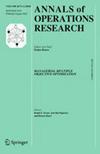Integrating multiple sources of ordinal information in portfolio optimization
Abstract
In this contribution we consider multiple qualitative views specified as total orders of the expected asset returns and discuss two different approaches for incorporating this input in a mean–variance portfolio optimization model. In the robust optimization approach we first compute a posterior expectation of asset returns for every given total order by an extension of the Black–Litterman (BL) framework. Then these expected asset returns are considered as possible input scenarios for robust optimization variants of the mean–variance portfolio model (max–min robustness, min-max regret robustness and soft robustness). In the order aggregation approach rules from social choice theory (Borda, Footrule, Copeland, Best-of-k and MC4) are used to aggregate the individual total orders into a single “consensus total order”. Then expected asset returns are computed for this “consensus total order” by the extended BL framework mentioned above. Finally, these expectations are used as an input of the classical mean–variance optimization. Using data from EUROSTOXX 50 and S&P 100 we empirically compare the success of the two approaches in the context of portfolio performance analysis and observe that aggregating orders by social choice methods mostly outperforms robust optimization based methods for both data sets and for different combinations of confidence and quality levels of the views.

 求助内容:
求助内容: 应助结果提醒方式:
应助结果提醒方式:


